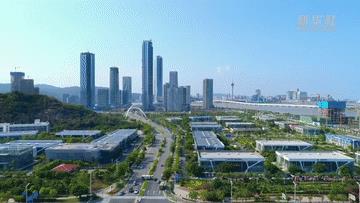The U.S. Defense Secretary visited Israel, saying that the war will transition from "large-scale fighting to low-intensity conflict."
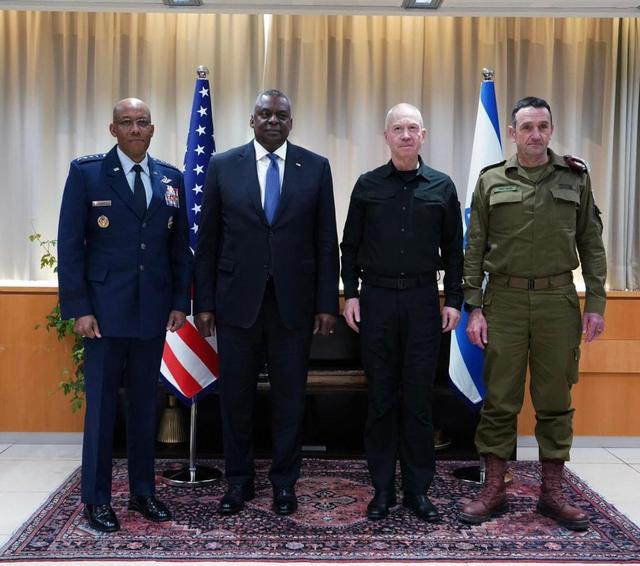
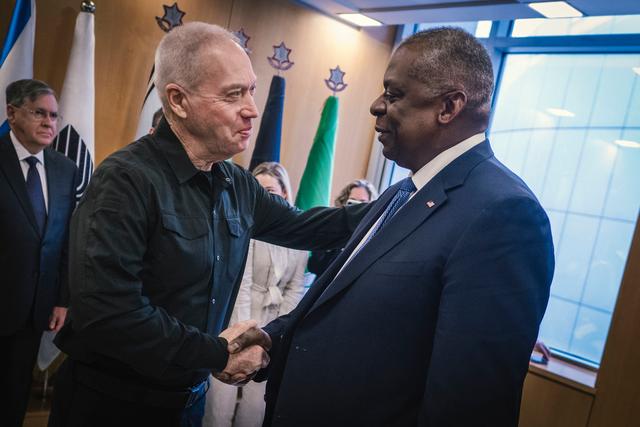
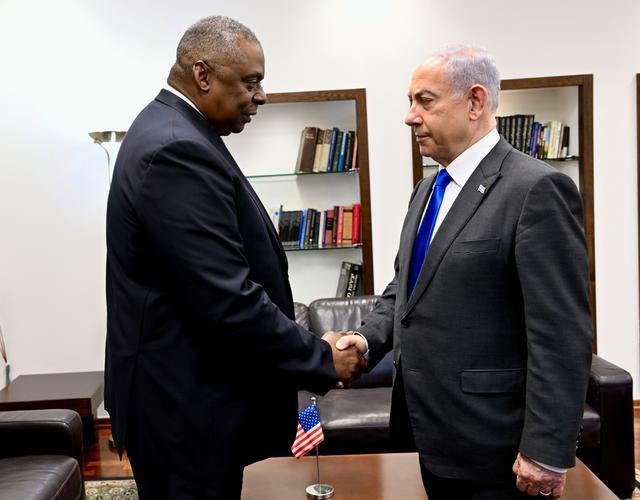



The current World Cup has entered the knockout stage. The wonderful game process and unpredictable results attracted more fans’ attention. On June 30th, Argentina-France match, CCTV’s multi-screen ratings entered the ranks of 4+ for the first time (4.29%), setting a new high for single event ratings since the start of the match.
The feast of the World Cup coincides with the integration of various platforms of the Central Radio and Television General Station. Taking stock of the communication effect data of this World Cup can reveal the powerful value and brand communication effect of CCTV.
First, the head platform for efficient aggregation of users
As of June 30th, the total number of users of the World Cup video broadcast by CCTV and new media content has exceeded.18.14 billion person-times. The World Cup quickly formed a super-large-scale communication effect in a short time, and together with a series of brand contents such as News Network, Spring Festival Evening, Golden Theater, live broadcast of major events, Olympic Games, etc., it formed a head resource platform for users to efficiently aggregate.
The promotion of media convergence provides an effective meeting point for the content interaction and collaborative operation of the platforms of the main station. By building a new media matrix and forming a one-button trigger mechanism, the efficient collaboration of various platforms on the new media side has played a positive role in the large-scale cross-screen communication of the World Cup. During the World Cup coverage, the users of multi-screen communication (TV screen, IPTV, web page, APP) based on the advantages of video at the main station always touched people for the following times.8.955 billion times; Based on the matrix communication of social media (Weibo, WeChat) on various platforms, users always touch people.9.185 billion times. Multi-screen video communication and social media secondary communication are basically the same in magnitude. Each platform integrates and cooperates to become a multiplier and accelerator for the cross-media communication of superior resources.
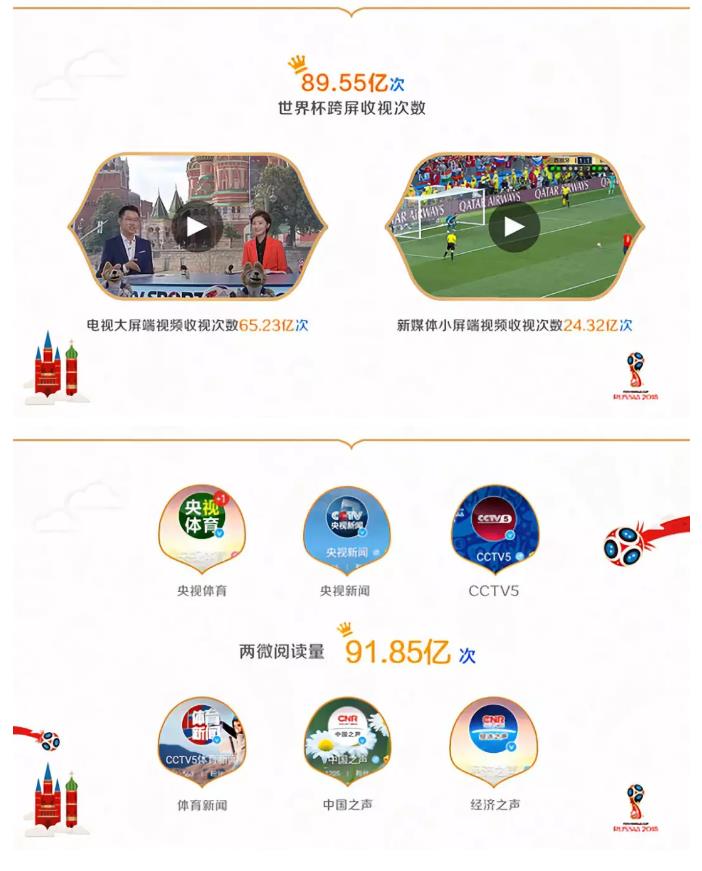
Second, the integration platform with high user stickiness
As of June 30th, the total time for users to watch the games on CCTV through live broadcast on big screen, playback in CCTV area, live broadcast on new media and on-demand is2.18 billion hours, multi-screen viewing users always reach for4.297 billion person-times, the average viewing time is30.53 minutes. It is equivalent to a 90-minute game, including the intermission. On average, each user only enters and exits less than three times, which shows the super high viewing stickiness.
The super-high viscosity of the World Cup ratings is closely related to the deepening of resource integration and the insistence on content-oriented after the integration of the main station, which makes the attraction of large and small screen platforms constantly improve. Since the establishment of the main station, major event reports and key innovative content have maintained a long-term user input in large-screen TV viewing and direct demand of new media.
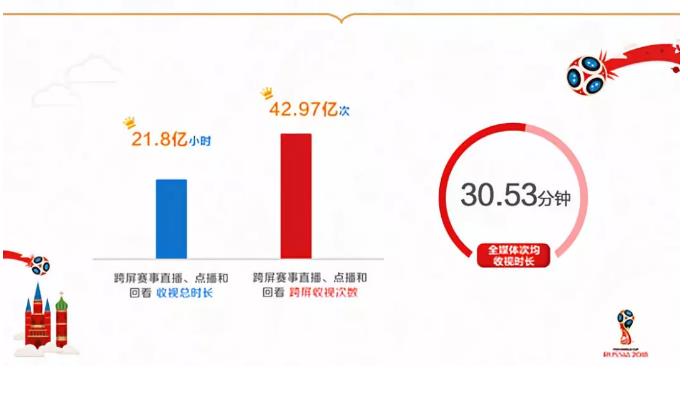
Third, the fusion platform of large and small screen collaboration
According to the data, as of June 30th, the total broadcast volume of CCTV World Cup live TV broadcast was2.328 billion person-times, the total broadcast volume of live and on-demand games with new media and multi-terminals is1.969 billion person-times.
In terms of absolute volume, the broadcast of sports events on TV and new media is "divided into two parts", which are mutually supportive. This fully reflects the implementation effect of the integrated main station in promoting advantage gathering, resource sharing and deep integration.
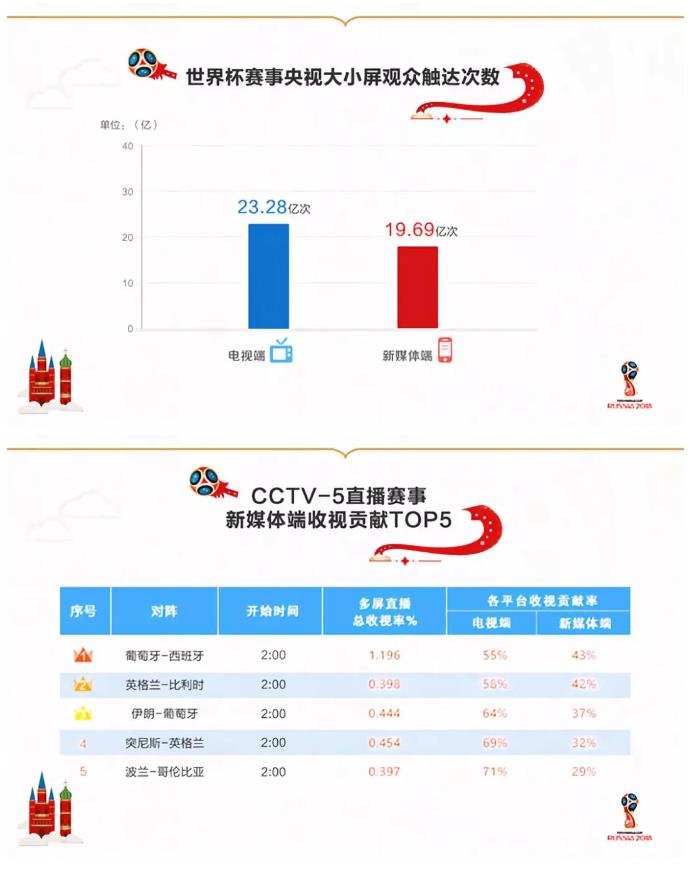
Fourth, a balanced service platform for the rapid growth of young audiences
The data shows that during this World Cup, the proportion of users of young people under 40 years old, such as CCTV Audio & Video, CCTV5, CCTV Microvision and other major broadcast clients under the Central Radio and Television General Station, exceeded 70%, becoming the absolute main force for watching the event. On the TV side, since the start of the World Cup, the number of young viewers under the age of 40 in the live broadcast period of CCTV-5 evening matches (20: 00-26: 00) has increased by 83 million compared with the same period before the game.
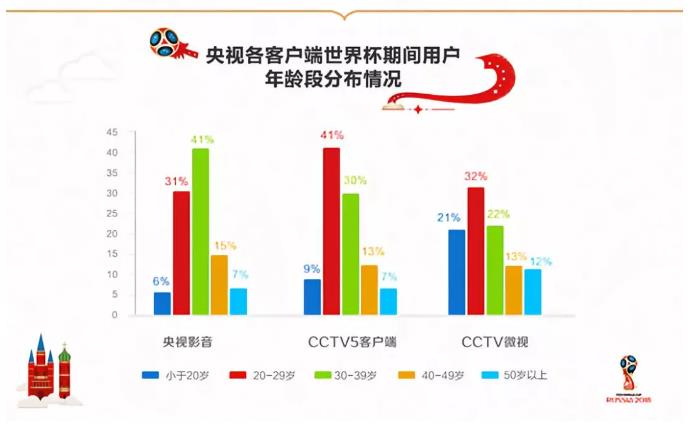
In the coverage of the World Cup, CCTV has expanded the all-media channels for content dissemination, met the diverse needs of users and achieved all-round service for users. The younger cross-media users of the World Cup and CCTV’s innovative programs show that the content advantages and platform advantages of CCTV, as a national media, are being reflected in more extensive and balanced communication advantages and user advantages through deep integration. (CCTV Editor-in-Chief of Central Radio and Television Station)
Behind the breakthrough of smart electric vehicles, automotive semiconductors are the key driving force. Therefore, automotive semiconductors have become one of the most potential racetracks, which are deeply concerned and supported by the government, industry, enterprises and capital. In order to empower the development of domestic automobile supply chain and vigorously cultivate automobile chip enterprises and industries, December 21, "2023 Suzhou Automotive Chip Industry Development Promotion Conference and Automotive Electronics Industry Investment Annual Meeting"It will be held in Suzhou Shishan International Conference Center.
The conference will be hosted by Suzhou Hi-tech Zone Management Committee, Suzhou Bureau of Industry and Information Technology, and Automotive Electronics Industry Investment Alliance. It will be hosted by Suzhou Hi-tech Zone Economic Development Committee, Suzhou Hi-tech Zone Commerce Bureau, Suzhou Hi-tech Integrated Circuit Industry Development Co., Ltd. and Aijiwei. With the support of China Automotive News, government leaders, experts and scholars, professional semiconductor investment institutions, local state-owned assets investment and invested enterprises will be invited to focus on "Intelligent driving, ecological interaction-"
Click to register.
Among them, the "Project Exchange and Sharing Meeting", as a highlight of this meeting, is organized by the Automotive Electronics Industry Investment Alliance.20+ invested enterprises related to car gauge chipsFace to face with investment institutions, automobile OEMs /Tier 1 enterprises directly. The CEO//chairmen of these 20+ enterprises will share the company’s development history, technological innovation and progress breakthroughs on the spot, and the best automobile-related awards will be announced at that time.
Through face-to-face communication and in-depth communication, all parties can fully understand each other’s needs and challenges, pay more attention to the coordination and complementarity between all links in the industrial chain, and then find opportunities and breakthrough points for cooperation, promote the development and upgrading of the whole industry through resource sharing and innovative cooperation, and create a new chapter for China’s automobile industry to become bigger and stronger.
"A single spark can start a prairie fire". The establishment and growth of these chip companies can also serve as a microcosm of the development of automobile chips in China, and better assistance can support their prosperity and development. Therefore, such centralized exchanges will help innovation chain, the industrial chain and the capital side to deeply integrate, open up the capital chain, the industrial chain and the resource chain, accelerate the growth of these companies and help the industrial development.
Established in September this year, the Automotive Electronics Industry Investment Alliance was jointly initiated by China Automotive News, Aijiwei, Dongfeng Asset Management, SAIC Hengxu, Geely Capital, Chang ‘an Capital, GAC Capital, BAIC Investment, Great Wall Capital, Xiaomi Investment and Weilai Capital. Its initial intention and ambition is to accelerate the innovation of automotive electronics technology in China, build an investment ecology in automotive electronics with China characteristics, and explore and build an innovative capital support model in China.
This project exchange meeting is also the first cross-border activity organized by the Alliance, and more activities to promote industrial integration will be launched in the future, so you are welcome to continue to pay attention.
List of participating enterprises
Weifa Electronic Technology (Changzhou) Co., Ltd.
Jiongyi Electronic Technology (Suzhou) Co., Ltd.
Bingling Intelligence Science and Technology (Changzhou) Co., Ltd.
Jiangsu Xin Changzheng Microelectronics Group Co., Ltd.
Jiangsu yuntu semiconductor co., ltd
Zhejiang jingneng microelectronics co., ltd
Wu Han ying fu nai si electronic technology co., ltd
Shenzhen yuanrong qihang technology co., ltd
Runxinwei Science and Technology (Jiangsu) Co., Ltd.
Shi Jia tou bo (Beijing) technology co., ltd
Shenzhen yuanshixin intelligent technology co., ltd
Qingdao ke Rui si de electronic technology co., ltd
Nanjing xinshiyuan electronics co., ltd
Anhui ousiwei technology co., ltd
Shenzhen basic semiconductor co., ltd
Xindingwei (Zhongshan) Photoelectric Semiconductor Co., Ltd.
Anhui xinta electronic technology co., ltd
Suzhou xinjian detection technology co., ltd
Xinyi Electronic Technology (Suzhou) Co., Ltd.
Chanz Yixin Technology (Nanjing) Co., Ltd.
Beijing huafeng technology co., ltd
In November, 2023, there were 70 online dramas and online movies registered in the "Information Filing System of Key Online TV Drama" of the State Administration of Radio, Film and Television, which met the relevant regulations on the production of original audio-visual programs on key networks. There are 39 online dramas with 921 episodes, and the realistic theme accounts for 48.7%. 266 episodes of 13 urban themes, 46 episodes of 3 public security themes, 64 episodes of 2 legendary themes, 16 episodes of 1 science fiction theme, 134 episodes of 6 martial arts themes, 12 episodes of 1 revolution theme, 33 episodes of 1 rural theme and 350 episodes of 12 other themes. There are 31 online movies, and the realistic theme accounts for 77.4%. 6 urban themes, 1 martial arts theme, 3 legendary themes, 5 rural themes, 3 youth themes, 2 public security themes, 1 science fiction theme and 10 other themes.
There are 8 online dramas with 171 episodes in Beijing, accounting for 20.5% of the national total, and the number of publicity is the second in the country. Realistic themes accounted for 62.5%; According to the theme, there are 3 urban themes with 50 episodes, 1 rural theme with 33 episodes, 1 sci-fi theme with 16 episodes and 3 other themes with 72 episodes. According to the age, there are 5 contemporary and 3 ancient.
A total of 7 online movies in Beijing were put on record and publicized, accounting for 22.6% of the national total, and the number of publicity was the highest in the country. Realistic themes accounted for 71.4%; According to the theme, there are 2 urban themes, 1 rural, youth, legend, martial arts and other themes; According to the age, there are 5 contemporary, 1 modern and 1 ancient.
The list of items is attached.
November 2023, Beijing’s key online drama shooting.
Record and publicize repertoire information

November 2023, Beijing’s key online film shooting.
Record and publicize repertoire information
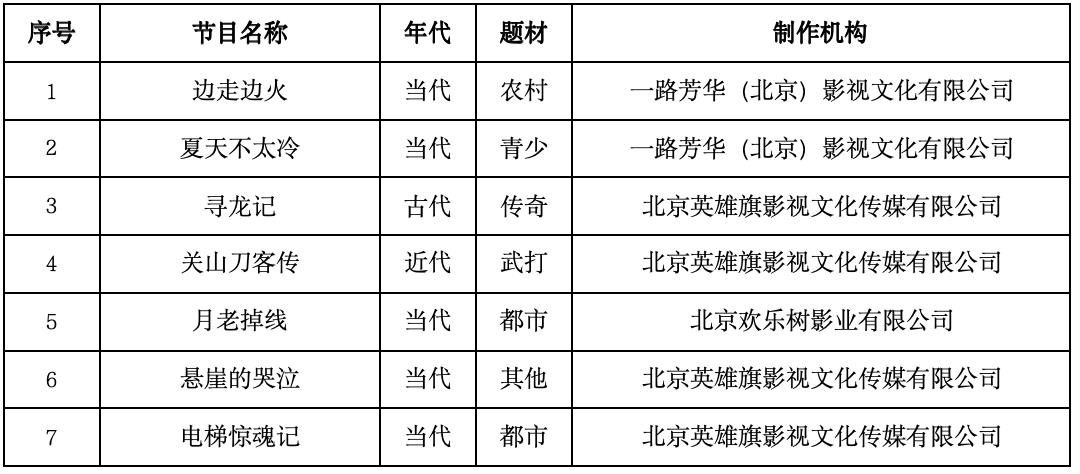
Source: Capital Radio and Television
In case of problems such as the content and copyright of the works, please contact this website within 30 days from the date of publication of the relevant articles. Contact number of copyright infringement: 010-85202353

When US Defense Secretary Robert Gates announced the defense budget for 2010 on the 6th, he stressed that the US military should drastically reduce the expenditure on R&D and purchase expensive and advanced armaments, and invest more resources to meet the equipment demand in real battlefields such as Iraq and Afghanistan. Analysts said that although it is still unknown whether Gates’s budget can be approved by the US Congress, it reflects a certain shift in the US military strategy.
Give up some "advanced" weapons
According to the defense budget submitted by Gates, the US military plans to reduce or stop some expensive arms production and R&D projects that are not needed at present.
As far as the navy is concerned, a plan to develop a new cruiser based on DDG1000 design will be abolished and the fleet upgrade plan will be suspended.
In the future, the navy will continue to use the main ship type "Ali Burke" class destroyer used in recent years.
It is said that the DDG1000 destroyer is a multi-functional warship that can avoid radar detection.
After the design of this destroyer, it was delayed to be delivered for manufacture, but the cost climbed to more than $3 billion per ship in the past 10 years. Therefore, the US Navy called for abandoning the project, but under the lobbying pressure of congressional interest groups, it only reduced the number of reserved ships from 32 to 3.
In the defense budget, Gates set the premise for purchasing the three ships under construction, that is, the contractor needs to move the two scattered construction sites to the same dock, otherwise the navy will only consider purchasing one of them.
As far as the Army is concerned, the $160 billion future combat systems R&D project will be cut.
Gates specifically pointed out that the chariot research and development project costing $87 billion in the system will be cancelled.
In view of the fact that roadside low-tech bomb attacks are the main cause of American casualties in the battlefields of Iraq and Afghanistan, Gates thinks that instead of developing light chariots with advanced concepts, it is better to spend money on anti-mine ambush vehicles. Based on a South African chariot in the early 1990s, this armored vehicle is said to have effectively reduced the casualties of American troops since it was put into use in Iraq.
For the Air Force, Gates intends to cancel the VH-71 presidential helicopter project costing $13 billion, the C17 new transport aircraft project and an advanced military satellite research and development plan, and at the same time reduce the production of each F-22 fighter at a cost of $140 million, which will be discontinued after 187 fighters are produced.
The F-22 fighter, nicknamed "Raptor", is the most expensive fighter in active service of the US military and the first fourth-generation fighter in the world. Although it has the functions of stealth and supersonic cruise, it is not suitable for helping the US military to deal with roadside bombs in Iraq or hunt down terrorists hiding in the mountains of Afghanistan. Gates said that F-22 fighters are of little use to American soldiers in Iraq and Afghanistan.
Increase the need of real war
While proposing to cancel and reduce many weapons programs, Gates announced that he would increase funds for other weapons programs. Gates suggested that the navy buy more ships with fast sailing speed, which is beneficial for the military to carry out offshore missions, and suggested that the Air Force increase the number of F-35 joint attack fighters purchased from 14 in fiscal year 2009 to 30 in fiscal year 2010, and the project funds increased from $6.8 billion to $11.2 billion. Gates also said that the Pentagon will increase the funds used to fight against anti-American militants in Iraq and Afghanistan, equip special forces to hunt down terrorists, stop reducing the number of air force and navy personnel, and expand the size of the US Army and Marine Corps, with an increase of 65,000 for the Army and 27,000 for the Marine Corps.
Gates also proposed to allocate $2 billion for the research and development and application of surveillance technology, including the addition of 50 Predator drones. It is said that since the beginning of this year, the US military has repeatedly dispatched Predators to crack down on Al Qaeda and Taliban forces hiding in the border areas of Pakistan and Afghanistan. Serve the "current war"
American public opinion believes that the main purpose of the defense budget submitted by Gates is to serve the "current war". The expensive armament project that Gates plans to cut is either a combat system formed during the Cold War or an advanced project aimed at mastering the hostile forces of super-sophisticated technology, which is not in line with the current situation. He stressed that what the United States needs is weapons that can be used to equip American soldiers to fight against real enemies.
The Los Angeles Times believes that Gates’ purpose is to shift the focus of military spending from large-scale wars against traditional rivals such as China and Russia to small-scale conflicts against armed forces such as the Taliban, which is the first step for the Obama administration to rebuild the US military. This fundamental and directional change in the focus of national defense spending is essentially to increase the ability of rapid deployment of troops, global response and information warfare, reduce the equipment needed for large-scale wars, and reduce the investment and installation of heavy equipment and traditional large-scale weapons development projects in accordance with the "need to guide contracts", rather than mainly considering meeting the requirements of various services and arms and indulging their selfish greed.
Correspondingly, the deployment of the US missile defense system may also be adjusted. In the defense budget submitted by Gates, the expenditure on missile defense projects will be reduced by $1.4 billion. He proposed to increase investment in regional anti-missile projects targeting missiles with short range and relatively limited strike capability, but to cancel or postpone the deployment of projects targeting intercontinental ballistic missiles.
Although the day before Gates’ defense budget was published, North Korea announced the successful launch of an experimental communication satellite, and arms dealers such as Boeing and Lockheed Martin took the opportunity to lobby that Gates would strengthen the existing multi-layer missile defense system in the United States in the defense budget, but it was not adopted in the end.
Military spending still ranks first in the world.
Analysts said that Gates’ defense budget was a helpless move when the United States was mired in the financial crisis and faced with financial difficulties. Gates himself said bluntly that the purpose of proposing to cancel those eye-catching sophisticated weapons programs is to save money.
Even so, once Gates’ plan was announced, it caused doubts in the United States. In addition to worrying about whether the United States has the ability to defend its homeland security after reducing conventional weapons, public opinion also believes that this plan will certainly not be approved by Congress. Because the plan harms the interests of arms dealers, these arms dealers will inevitably put pressure on members of Congress who represent their interests and obstruct the adoption of the plan. Even if it is passed, it must be transformed in the implementation.
International public opinion generally believes that the so-called worry about the impact of Gates’ reduction of the defense budget on American security is simply unnecessary, because Gates’ plan to reduce large-scale advanced weapons and equipment is itself based on "the United States’ military strength is the only one." Although many armament projects have been drastically reduced, the total defense budget submitted by Gates in 2010 will still reach $534 billion, up from $519 billion in 2009. In fact, the total defense budget of the United States has accounted for more than 40% of the global military expenditure for many years. If the cost of counter-terrorism is added, its defense expenditure is almost equivalent to the sum of all other countries and regions in the world.
Editor: Li Yongchao




